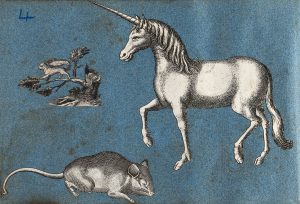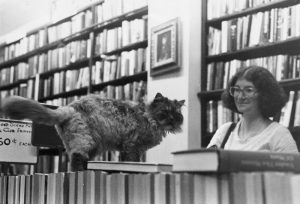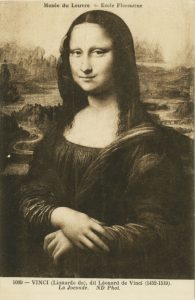4 But What Does It Mean?
J. Keri Cronin and Hannah Dobbie

In the summer of 2023 a legal case in Saskatchewan made headlines when the judge ruled that the “thumb’s up” emoji was legally binding in terms of contract obligations. When speaking about the case, Justice Timothy Keene noted that considerable effort was made to determine the meaning of this particular emoji.
While this is a somewhat amusing story (although certainly not for the parties involved), it highlights something very important when we are dealing with images: how do we know what an image means?
This is a complex question. There are many factors that shape the ways we understand and make sense of an image. But here are some important things to keep in mind:
- The meaning of an image is not fixed or static. This means it can and does shift.
- The artist or image-maker can have an idea about what they want people to understand about an image but this is always only one of the possible meanings generated.
- Looking at images is a social practice–even when we are by ourselves, there are broader social forces influencing us.
- The value of a work can shape its meaning. Many factors determine the value of an image.
When considering how images make meaning, we need to consider things like:
- What other images are nearby?
- What other senses are engaged? (think about smells, sounds, etc.)
- What kind of space is the image viewed in? (An art gallery? A thrift shop? A hospital? On the pages of a newspaper?)
- What kinds of lighting or other technologies are present?
- What kinds of preconceived ideas does the viewer bring to the process of looking?
- Who else is in the room? Friends? Strangers? Classmates? Enemies?
We could add many more questions to this list, but the point is that the context in which an image is viewed has an influence on our understanding of it. Further, we all bring our own experiences, backgrounds, knowledge, preferences, and biases to the reading and understanding of images. Even though it is often useful or interesting to know about the intention of the producer, it is only part of the story. In other words, the meaning that the artist or image-maker intended is not necessarily the meaning that a viewer might receive.
Ok, sounds good, right? But what does that actually mean? Let’s do a practice exercise to help illustrate some of these concepts.

Writing Exercise
Take 5 minutes and do some freewriting about this photograph by Tim Baker.
- What do you notice?
- What is this a picture of? (this is not a trick question!)
- What do you find most interesting about this image?
- How would you describe this image?
- What does this image make you think of?
Remember, freewriting is supposed to be rough, unedited, disjointed. It isn’t for others to see. Rather, it is a practice to help you formulate your thoughts.
In this writing exercise, some of you might have focused on the cat, who we discover was named Lady Jane Grey when we follow the link under the image. Some of you might have focused on the unnamed woman looking at the cat. How interesting that we are told the name of the cat but not the woman!
Now let’s delve a little further and think of some of the possible meanings that could be generated through this one image. For example:
- Imagine you are a veterinarian or a cat breeder. You might look at this picture from that perspective. Perhaps you have specialised knowledge about cats that an average viewer wouldn’t. How would this knowledge shape how you saw the picture?
- What if you had a serious allergy to cats? How would this influence the way you looked at this picture?
- Imagine you are a relative of the woman in the picture. This photograph was taken over 40 years ago, so discovering it might be a wonderful connection to your family and their past. Or maybe it stirs up uncomfortable or difficult memories for you.
- Maybe you are a historian focusing on the city of Chicago and want to know more about shops like this one, O’Gara and Wilson’s antique book shop. What information could this photograph give you?
As you can see from this brief example, the process of generating meaning from a single image is complex. None of the meanings generated through the imagined scenarios above are more “correct” than the other and none are likely connected to the photographer’s motivation for taking this picture in the first place.
Value
The concept of “value” is a significant one to consider when we are thinking critically about visual culture. Of course there are many different kinds of value including personal, economic, social, and cultural. While these different types of value can overlap, they are not interchangeable. For example, a photograph may hold tremendous personal value to you but not be worth much (or anything) in monetary terms.
The world of art is deeply intertwined with economic systems and, as such, monetary value has become part of the complex way an image’s meaning is understood. The price fetched for famous paintings at auctions becomes part of that picture’s story, another layer of meaning added to the way the image is understood.
For example, in 2017 the sale of a painting that many believe to have been painted by Leonardo da Vinci broke records when it sold for over $450 million U.S. dollars. This picture, titled Salvator Mundi (Latin for “Saviour of the World”), has been controversial because experts have not been able to agree for certain whether or not it was painted by Leonardo da Vinci. In this case, the value of the picture (and this high price tag!) is wrapped up with the identity of the artist. In short, if it can be proven that Leondardo da Vinci painted the picture, its economic value rises. If it can be proven that someone else painted the picture, its economic value drops. The picture itself doesn’t change. The subject matter and materials used remain the same. The value fluctuates based on the identity of the artist.
“The Aura”
The concept of “the aura” is related to the value of an image. “The aura” is a concept that was explored by Walter Benjamin in a 1936 essay called “The Work of Art in the Age of Mechanical Reproduction.” Here Benjamin writes about the difference between an original work of art and reproductions of the same picture. The aura explains why an original painting by Leonardo da Vinci holds so much economic value whereas the same picture reproduced on coffee mugs, throw pillows, posters, calendars, and notecards does not. Benjamin describes that sense of uniqueness that accompanites an original work of art. For Benjamin, standing in front of an original painting or sculpture is an entirely different experience than looking at a photographic reproduction of it–there is a sense of authenticity that isn’t present in copies of that artwork. As he writes, “Even the most perfect reproduction of a work of art is lacking in one element: its presence in time and space, its unique existence at the place where it happens to be.” He goes on to argue that “the presence of the original is the prerequisite to the concept of authenticity.”[1]
And yet it is important to recognise that reproductions of image can help to bolster the value of the original. In other words, we get to know certain images through reproductions. We haven’t all travelled to Paris to see the Mona Lisa, but many of us can recognize it because it has been reproduced countless times.

Museums and art galleries can reinforce “the aura” of a work of art. The way a work of art is presented can suggest the value of the piece. By installing red velvet ropes to keep visitors back or security systems to protect a picture, museum and gallery staff reinforce the idea that the picture being protected is special, unique, or different. We may be encouraged to buy a reproduction of it in the institution’s gift shop, but we know that experience is different than standing in front of the original picture. By participating in this dynamic, viewers and visitors to the gallery internalise and reinforce the sense of value attached to the image.
Why Did She Take These Pictures?
We will turn to the life and work of the photographer Vivian Maier for our next example as this case study further illustrates how complicated the meaning-making process can be when the question of value gets added into the mix.
Vivian Maier worked as a nanny in New York and Chicago in the mid 20th century (1950s and 1960s), but she also was an avid photographer. She took photographs of the world around her, mostly urban spaces in mid 20th century America. She also took a number of self-portraits (in both colour and black and white), often creatively using shadows and reflections to do so. Until relatively recently her work was virtually unknown by the art world.
Maier’s photographs were not exhibited in her lifetime. Very little is known about her, as she was a very private person and kept to herself.
In 2007 a storage locker of items belonging to Vivian Maier was discovered. It was full of things she had saved, including things like old paint cans. But it also included photographs and undeveloped rolls of film. These items were sold at auction, and the collectors who bought them recognized that these were interesting images.
There have been many exhibitions of her work. There have also been books published about her photography and a handful of documentary films about her life and work. (Note: if you are a current Brock student you can watch the film called Finding Vivian Maier through the Brock library. You will have to log in with your student credentials to access it.)
There is also a complex legal battle that continues to brew about the ownership of these images. Maier died in 2009 and, at the time of her death, her images were still, for the most part, unknown. She didn’t have a will, and she left no instructions about what she wanted done with this vast trove of images. The collectors who had bought her images from the auction didn’t meet her or even know how to find her.
For our purposes in this chapter, what is especially interesting is that these are images that Vivian Maier herself didn’t show much interest in having exhibited or published. She kept them to herself and didn’t even develop all of the film.
What does it mean collectors are now exhibiting, selling, and publishing her work? Would she even want them shown? She didn’t have the opportunity to edit them the way most photographers would before their work is exhibited.
Other questions that come to mind: what was her intention when she took these images? Are they social documents? Art? Who gets to decide? (And let’s not forget the “myth of photographic truth” we looked at in the previous chapter!)
A number of Maier’s photographs were recently donated to the Special Collections Research Centre at the library of the University of Chicago. Daniel Meyer, one of the archivists at the University of Chicago, believes that these images held meaning for Vivian Maier because they were ones she chose to have developed and printed.
Vivian Maier’s photographs are now considered valuable but they weren’t in her lifetime. This illustrates how the idea of “value” is complicated and not fixed. These photographs have a couple of different types of value. First of all, they quite likely had a sense of personal value for Maier herself, but to date there has been no information about her intentions with these images discovered. Secondly, these photographs have value as historical documents, in that they give us a glimpse of aspects of a certain time and place. (Keeping in mind, of course, that we need to be critical thinkers and viewers and not necessarily accept photographs as “true.”) And, lastly, these images also have monetary value. For example, one of the men who collected Vivian Maier’s work, John Maloof, is now offering prints for sale through a New York art gallery.
So, How Do I Know What An Image Means?
As we have established, there is no one fixed way to understand an image. An artist or image-maker likely had a certain idea in mind when they made the image, but there is absolutely no guarantee that this will be the meaning a viewer takes from it.
The fact that many different viewers might have different responses to the same image does not mean “anything goes” when thinking about how an image creates meaning. When discussing (or writing about) visual culture it is important to ground your discussion in detailed visual and contextual analysis–this helps to explain why you have arrived at your conclusions. You need to gather this information as a form of “evidence” to help build your argument.

The image above is a watercolour painting by a British artist named Robert Humphrey Giles. He was active in the 19th century, but the specific date of this painting is unknown. This is one of several paintings from this era that deal with the theme of illness, health, and medicine.
Reflection Exercise
- Take a close look at the Giles painting above and jot down some points you would include in a visual analysis of this image.
- Now make a list of some of the various approaches different viewers might bring to this image. For example, would a fashion historian working today understand this image differently than the mother of the woman who posed for this picture? How come? What other possible meanings could you imagine for this painting?
Remember–not everyone is going to see the image in the same way! Our level of education, background, culture, and past experiences influence how we make sense of the images we look at.
It is also important to remember that the context in which an image is viewed can change the way a viewer understands an image. So if a painting is framed and hanging on the wall of a famous art gallery we might make different assumptions about it than if, say, it was reproduced in a clothing advertisement or hanging in a mechanic’s shop. Where we encounter an image can shape our expectations of it and, in turn, can influence how we interpret that image.
Reinterpretation
The meaning of an image shifts with the context it is viewed in. A powerful example of this is American artist Jennifer Davis Carey’s recent series called “Redemption.” With this work, she reinterprets daguerreotypes of enslaved African Americans, images made in 1850 by a photographer named J.T. Zealy. Zealy was working for Louis Agassiz, a professor of zoology and geology at Harvard. Agassiz’s views on race are recognized as deeply problematic today, and these photographs are evidence of this.
Carey took these difficult images as the point of entry for her artwork–she refers to them in an artist talk as “an assault on the senses and an assault on the soul.” She was driven to transform these images as a way to restore a sense of dignity and humanity to the people who posed in front of Zealy’s camera in 1850. She used a process called vitreous enamelling to make it appear as if the men and women depicted in these daguerreotypes were wearing clothing (Agassiz posed them naked), a gesture intended to move them out of the realm of “specimen” (as Agassiz would have understood them) and instead present them as portraits of individuals.
In 2019 there was a legal challenge brought against Harvard over their ownership and use of the Zealy daguerreotypes. Tamara Lanier, a relative of two of the people photographed by Zealy–Renty Taylor and his daughter Delia–took Harvard to court for damages related to the production and circulation of these images as well as over the issue of ownership of the images. Harvard won that legal battle, but one of the outcomes of this case was that the images have been released into the public domain.
This is a powerful and important example of how the meaning of an image can shift depending on the context in which it is viewed.
Understanding how images generate meanings and how they shape (or challenge) dominant ideas is a complex process. We are just starting to scratch the surface in this course, but hopefully the examples in this chapter have demonstrated the importance of paying attention to these kinds of questions when we encounter images in our day-to-day lives.
Reflection Exercise
As we have seen in this chapter, the way an image generates meaning is very complex. Spend 5-10 minutes freewriting on the topics explored here. If you don’t know where to begin, here are some questions to get you started:
- Was there anything in this chapter that surprised you?
- Can you think of an example of an image from your own life that might hold different meanings for different viewers?
- How might the information from this chapter shape the ways in which you view or make images in the future?
Remember–there are no right or wrong answers here. Freewriting is a tool to help you solidify some of the thoughts you are having on any given topic.
- Walter Benjamin, "The Work of Art in the Age of Mechanical Reproduction," in Illuminations: Essays and Reflections, 217-251. New York: Shocken, 1968. ↵

